
The Contextual Kits for T2CT have been designed to enhance thermal place preference studies...

The Contextual Kits for T2CT have been designed to enhance thermal place preference studies...
Discover our products
An easy way to objectively quantify the muscular strength of mice and rats, and to assess the...
Discover our products
The BIOSEB Spontaneous Activity Wheel offers an effective solution for quantifying rodent...
Discover our products
The BIOSEB Spontaneous Activity Wheel is an easy way to quantify rodent voluntary activity in...
Discover our products
The uncomplicated way to monitor rodent activity over several days from their home cage...
Discover our products
These small animal treadmills are used for forced exercise training and accurate testing of...
Discover our products
For testing animal's thermal sensitivity to pain resulting from exposure to heat or cold: the...
Discover our products
An operator independent test to study pain thresholds in rodents (mouse and rat) by assessing...
Discover our products
New and improved! The operator-independent Thermal Gradient Test used to show favorite...
Discover our products
The Contextual Kits for T2CT have been designed to enhance thermal place preference studies...
Discover our products
The advanced version of our Dynamic Weight Bearing Test for rodents (rats and mice) allows for...
Discover our products
An easy and non pain-inducing solution for assessing the level of discomfort (incapacitance) in...
Discover our products
A unique device that provides automated measurement of weight bearing and force distribution...
Discover our products![Dynamic Weight Bearing 2.0 – Postural Module [Add-on]](https://bioseb.com/733-home_default/dynamic-weight-bearing-20-add-on-postural-module.jpg)
Expand Your Analysis with Advanced Postural and Locomotor Calculations BIOSEB’s renowned...
Discover our products
A quick solution to determine the mechanical sensitivity threshold in rodents (mice and rats)....
Discover our products
As an electronic version of the classical Von Frey Filaments esthesiometer (or aesthesiometer),...
Discover our products
New ROBUST and modular cages to gently hold rodents (rats or mice) during nociceptive and...
Discover our products
An economical and versatile solution for when flexible quantitative sensory testing (QST) is...
Discover our products
Dedicated to small animals, like mice and rats, Smalgo is a pressure-based analgesimeter...
Discover our products
Bioseb's version 5 of the Tail Suspension Test system, based on both strain sensors and video...
Discover our products
NEW ! A complete (hardware + software), dedicated and automated solution for the Elevated Plus...
Discover our products
A unique setup for the automation of the Open Field test for rats and mice : 3D-camera based...
Discover our products
Open-field test - ARENA ONLY - used to evaluate of animal's basal activity and its evolution for...
Discover our products
The new Forced Swimming Test system from Bioseb uses a dual approach: Combining a double input...
Discover our products
A brand new innovative setup for the automation of the Novel Object Recognition Test : 3D-camera...
Discover our products
Open-field test - ARENA ONLY - used to evaluate of animal's basal activity and its evolution for...
Discover our products
An entirely modular experimental enclosure designed to conduct operant conditioning procedures...
Discover our products
A standard experimental chamber for automated or manual assessment of conditioned place...
Discover our products
Real-Time Physiological Monitoring for Small Animals – Wireless & Non-Invasive The Bioseb...
Discover our products
The ETH-401 is a bridge amplifier for various transducers that provides four channels of...
Discover our products
The IX-118 is a fast 100 Khz, high-resolution data acquisition system suitable for most data...
Discover our products
The ETH-256 is a 2 channels high performance, general-purpose life science research amplifier,...
Discover our products
Full-featured multi-channel stimulator for neuromuscular stimulation
Discover our products
Discover BIO-FOODIS, the next generation solution for understanding animal feeding behavior with...
Discover our products
The OXYLET system - Physiocage is a modular system allowing the integration of respiratory...
Discover our products
Innovative and appropriate equipment for measuring food/liquid consumption and correlated motor...
Discover our products
An economical, high performance Oxygen and Carbon Dioxide Analyzer with sampling rates fast...
Discover our productsA fast and accurate algometer based on an instrumented pincher as an alternative to the Randall-Selitto test: This new analgesia meter developed by Bioseb following Luis-Delgado et al. (2005) allows accurate nociceptive tests to measure mechanical pain threshold on rat or mouse limbs with minimal constraint. Now wireless, to be free from annoying cables!
![]()
![]()
![]() Presentation
Presentation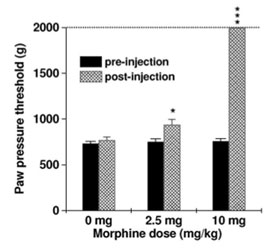 Bioseb's 'Rodent Pincher' algometer allows calibrated forceps to induce quantifiable mechanical stimulation in the animal (rats or mice) on a linear scale. The most suitable protocol was experimented by determining the effects of 3 repetitive measurements on the 2 hindpaws, respectively over long-term (9 days), mid-term (1 day) and short-term (2 hours). It was primarily developed as an analgesimeter/algometer (analgesia measurement instrument) for nociceptive tests. In this specific use, the Rodents Pincher not only represents an alternative to the 'RANDALL & SELITTO' test - but also presents the following advantages when compared to the classical test:
Bioseb's 'Rodent Pincher' algometer allows calibrated forceps to induce quantifiable mechanical stimulation in the animal (rats or mice) on a linear scale. The most suitable protocol was experimented by determining the effects of 3 repetitive measurements on the 2 hindpaws, respectively over long-term (9 days), mid-term (1 day) and short-term (2 hours). It was primarily developed as an analgesimeter/algometer (analgesia measurement instrument) for nociceptive tests. In this specific use, the Rodents Pincher not only represents an alternative to the 'RANDALL & SELITTO' test - but also presents the following advantages when compared to the classical test:
• More ethical handling, less stressful for the animal (rat or mouse) resulting in less variable measurements
• Faster measurement, less traumatic for the tissues
• Digital measurement with metrological traceability
Furthermore, this pincher-based analgesia meter can also be used for other applications that require a controlled force or pressures values, for example :
• Sensitivity recovery after nerve crush: pinching is applied at several places over the paw to see the sensitivity recovery
• Mechanical injuries for thrombotic models
• Mechanical stimulation for in vivo electrophysiological recordings using the possibility to trigger recording on force thresholds
Comparative studies (including comparative tests with the Randall & Sellito analgesimeter) have demonstrated the accuracy of this pincher-based algometer for easy, fast and reproducible measurement of mechanical pain threshold on rat limbs. Moreover, it allowed to perform rat analagesia testing with minimal constraint, which reduces data variability.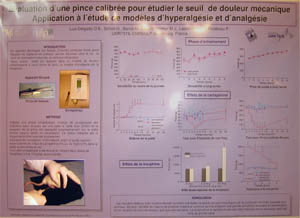
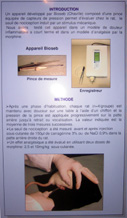 One of these experimental research works was carried out by the team of Prof. Poisbeau in the 'Nociception & Pain' department of the 'Institut des Neurosciences Cellulaires et Intégratives' (Université Louis pasteur) in Strasbourg.
One of these experimental research works was carried out by the team of Prof. Poisbeau in the 'Nociception & Pain' department of the 'Institut des Neurosciences Cellulaires et Intégratives' (Université Louis pasteur) in Strasbourg.
This work was described in two articles published in December 2005 in international reviews with a controlling committee:
• Validation method :
Calibrated Forceps: A Sensitive and Reliable Tool for Pain and Analgesia Studies, by Luis-Delgado et al. in The Journal of pain, December 2005
• Scientific work :
Inflammatory Pain Upregulates Spinal Inhibition via Endogenous Neurosteroid Production, by P. Poisbeau et al. in The Journal of neuroscience, December 2005
![]() Operating principle
Operating principle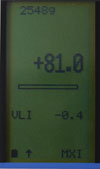
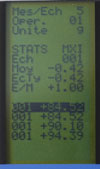 The pressure is applied in the 'inter-digital' region. When used on the rat the pressure can also be applied to the tail. The instrument displays the force (in grams, newton, oz, lbs) at which the animal reacts and reports the nociception threshold.
The pressure is applied in the 'inter-digital' region. When used on the rat the pressure can also be applied to the tail. The instrument displays the force (in grams, newton, oz, lbs) at which the animal reacts and reports the nociception threshold.
Individual pain threshold measurements (up to 100) are stored in the internal memory, and can be downloaded post experiment. Recently an embedded statistical computation has been included in the electronic device of the algometer. This is a very useful feature that as been very well received and used by users of large numbers of tests. The display shows in real time the mean, standard deviation and variation coefficient from groups of animals (rats or mice). This feature also allows the user to cancel any analgesia test incorrectly performed.
![]() NEW: Wireless
NEW: Wireless
A full range of devices, including the Rodent Pincher now feature our new Wireless technology: thanks to the wireless transmitter on the operator’s wrist, there is no more cable between the electronic unit with the display and the sensors.
This new, wireless technology offers numerous advantages:
• Improved User range of motion : free from annoying cables !
• Flexible setup within the lab : Design your behavior room with fewer limitations
• Get rid of the physical constraints: Focus on your experiment only !
![]() Options
Options
• Our optional BIO-CIS2 software for Windows sends directly the displayed values in an Excel (MS) sheet. This allows the user direct access to a ready report and options for further analysis, without any re-copy error. Supplied with an RS232 cable.
• External pod to display a led light or produce a sound when reaching a preset threshold of force.
• Analog output and cable
• TTL output
• Additional sensor tests : our Electronic Von Frey probe, Small Animal Algometer come with their own calibration modules that are recognized by the electronic unit.![]() Supplied with
Supplied with
• Bench control unit (batteries and main power supply)
• One rat or mice pincher, capacity 2000 grs
• Carrying case
• Footswitch for zeroing the force and having the hands 'free'
• RS232 output
• User manual![]() New system! AlgoKit
New system! AlgoKit
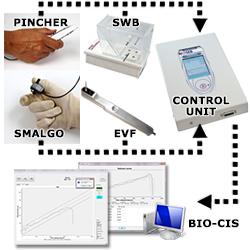
You may consider our new ALGOKIT package to expand the scope of your possibilities. In order to offer an answer to all your requests regarding different situations of pain measurement, Bioseb is proud to present an innovative, complete solution combining our Static Weight Bearing, including its state-of-the art touchscreen, color console, with up to 3 sensors to be chosen among our Electronic Von Frey, Rodent Pincher and Small animal Algometer, all connected to one unique Control Unit.
Features:
• Flexible instrument when a quantitative sensory testing (QST) is needed
• Compatible with our BIO-CIS2 software to improve repeatability in nociceptive testing
Data sheet
Number of publications:
A quick solution to determine the mechanical sensitivity threshold in rodents (mice and rats).
As an electronic version of the classical Von Frey Filaments esthesiometer (or aesthesiometer), the latest evolution of...
New ROBUST and modular cages to gently hold rodents (rats or mice) during nociceptive and analgesic tests including...
check_circle
check_circle